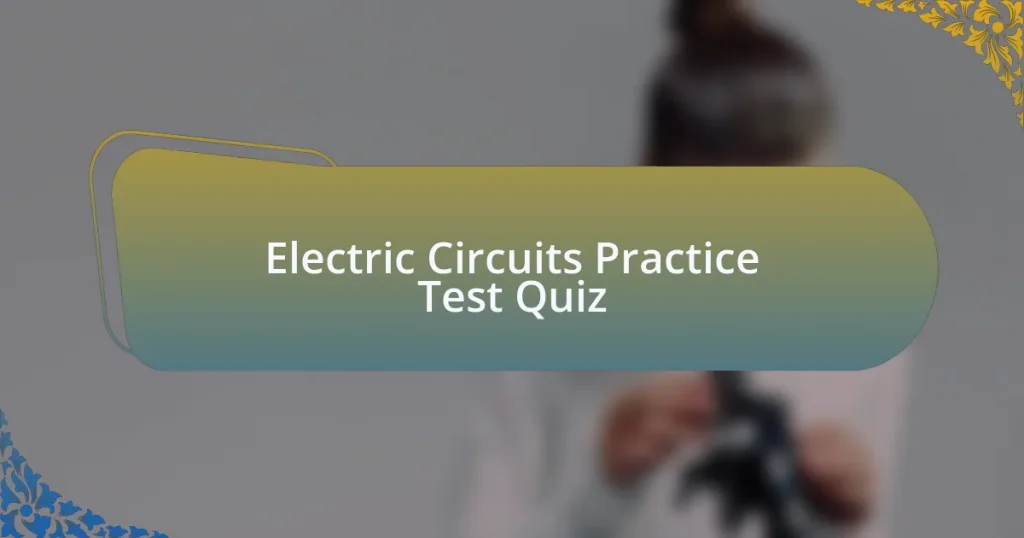Start of Electric Circuits Practice Test Quiz
1. What is an electric circuit?
- An electric circuit is a collection of random wires with no purpose.
- An electric circuit is a series of components that stores electric charge.
- An electric circuit is an open path for magnetic current to flow.
- An electric circuit is a closed-loop path through which electric current flows.
2. What is the purpose of a conductor in an electric circuit?
- To allow electric current to flow through it.
- To store electric energy for later use.
- To transform electric energy into heat.
- To block electric current from flowing.
3. What is the function of a switch in an electric circuit?
- To store electric energy for later use.
- To increase the voltage across the circuit.
- To convert direct current to alternating current.
- To open or close the circuit.
4. What is the unit of measurement for electric current?
- Ohms (Ω)
- Watts (W)
- Amperes (Amps)
- Volts (V)
5. What is the unit of measurement for electric resistance?
- Watts (W)
- Amperes (A)
- Volts (V)
- Ohms (Ω)
6. What is the unit of measurement for electric power?
- Amperes (A)
- Volts (V)
- Watts (W)
- Joules (J)
7. What is an example of a load in an electric circuit?
- A battery.
- A light bulb.
- An insulator.
- A switch.
8. Which component provides energy to the charged particles in an electric circuit?
- A resistor.
- A switch.
- A capacitor.
- A power source, such as a battery.
9. What is the function of a fuse in an electric circuit?
- To protect the circuit from excessive current.
- To measure the voltage in the circuit.
- To allow electric current to flow easily.
- To increase the current in the circuit.
10. What is the difference between a series circuit and a parallel circuit?
- In a series circuit, components are connected only if they are the same type, while in a parallel circuit, any components can be connected.
- In a series circuit, components are connected one after the other, while in a parallel circuit, components are connected between the same two points.
- In a series circuit, components are connected at random, while in a parallel circuit, components are connected in a single line.
- In a series circuit, each component has its own separate power source, while in a parallel circuit, they share a power source.
11. What is Kirchhoff`s Law?
- Kirchhoff`s Law states that current is always constant in a circuit.
- Kirchhoff`s Law states that energy is conserved in a circuit only when it`s closed.
- Kirchhoff`s Law states that voltage can never decrease in a circuit.
- Kirchhoff`s Law states that the sum of all voltage changes around a closed loop in a circuit is zero, and the sum of all currents entering a node is equal to the sum of all currents leaving the node.
12. What is the function of an ammeter in an electric circuit?
- To increase the current flowing through a circuit.
- To prevent current from flowing in a circuit.
- To measure voltage across a circuit.
- To measure the current flowing through a circuit.
13. What is the function of a voltmeter in an electric circuit?
- To measure the current flowing through a circuit.
- To measure the voltage across a component in a circuit.
- To protect the circuit from excessive current.
- To open or close the circuit.
14. What is Ohm`s Law?
- Ohm`s Law states that current (I) is equal to voltage (V) divided by resistance (R): I = V / R.
- Ohm`s Law states that resistance (R) is equal to current (I) multiplied by voltage (V): R = I * V.
- Ohm`s Law states that voltage (V) equals power (P) divided by resistance (R): V = P / R.
- Ohm`s Law states that voltage (V) is equal to current (I) multiplied by resistance (R): V = I * R.
15. What happens to the voltage in a series circuit when one bulb goes out?
- The voltage remains the same across all bulbs in the circuit.
- The voltage drops over each load in the series circuit.
- The voltage increases for the remaining bulbs in the circuit.
- The voltage becomes zero when one bulb goes out.
16. What happens to the current in a parallel circuit when one bulb goes out?
- The current increases dramatically in the parallel circuit.
- The current continues to flow through the other bulbs in the parallel circuit.
- The current stops completely in the parallel circuit.
- The current flows only to the burned-out bulb in the parallel circuit.
17. How is resistance measured in an electric circuit?
- Volts (V)
- Ohms (Ω)
- Watts (W)
- Amperes (Amps)
18. What is the effect of adding more resistors in series on the overall resistance of the circuit?
- The overall resistance stays the same.
- The overall resistance decreases.
- The overall resistance fluctuates.
- The overall resistance increases.
19. What is the effect of adding more resistors in parallel on the overall resistance of the circuit?
- The overall resistance decreases.
- The overall resistance increases.
- The overall resistance fluctuates.
- The overall resistance stays the same.
20. What is the purpose of a circuit breaker in an electric circuit?
- To increase the voltage in the circuit.
- To store electrical energy for later use.
- To measure the amount of current flowing.
- To protect the circuit from excessive current and prevent electrical fires.
21. What is the unit of measurement for electric potential difference?
- Watts (W)
- Volts (V)
- Amperes (A)
- Ohms (Ω)
22. What is the function of an insulator in an electric circuit?
- To increase the flow of electric current through it.
- To decrease the resistance in the circuit.
- To allow electric current to travel freely in the circuit.
- To prevent electric current from flowing through it.
23. What is the difference between a conductor and an insulator?
- Insulators allow electric current to flow, while conductors prevent it.
- Conductors allow electric current to flow, while insulators prevent it.
- Conductors prevent electric current from flowing, while insulators allow it.
- Both conductors and insulators allow electric current to flow equally.
24. What is the effect of increasing the voltage on the current in a circuit?
- The current decreases, assuming constant voltage.
- The current increases, assuming constant resistance.
- The current remains constant, regardless of voltage.
- The current oscillates unpredictably with voltage changes.
25. What is the effect of increasing the resistance on the current in a circuit?
- The current doubles, assuming constant resistance.
- The current remains constant, assuming variable voltage.
- The current increases, assuming constant voltage.
- The current decreases, assuming constant voltage.
26. What is the function of a relay in an electric circuit?
- To limit the voltage in the circuit.
- To measure the resistance of a component.
- To provide a path for current to flow.
- To act as both a load and a switch.
27. What is the purpose of a ground wire in an electric circuit?
- To increase the voltage in the circuit during operation.
- To provide a safe path for electrical current to flow to the ground if there is a fault in the circuit.
- To store electric charge for later use.
- To convert AC into DC for circuit operation.
28. What is the difference between a direct current (DC) and an alternating current (AC)?
- DC is used for high voltage, while AC is for low voltage.
- DC and AC are the same type of current.
- DC flows in one direction, while AC changes direction periodically.
- AC flows in one direction, while DC changes direction periodically.
29. What is the purpose of a fuse or circuit breaker in a household electrical system?
- To provide energy to the charged particles.
- To protect the system from electrical overloads and short circuits.
- To increase the voltage in the circuit.
- To measure the current flowing through the circuit.
30. What is the effect of an open circuit on the flow of electric current?
- Current flows at double the rate.
- Current flows freely without resistance.
- No current flows through an open circuit.
- Current flows only in one direction.
Congratulations! You’ve Successfully Completed the Electric Circuits Practice Test
Well done on finishing the Electric Circuits Practice Test! You’ve taken an essential step in your Physics Test Preparation journey. Throughout this quiz, you explored key concepts such as Ohm’s Law, circuit components, and the principles of voltage and current. Each question was designed to enhance your understanding of how electric circuits function, building a strong foundation for further studies.
As you navigated the different scenarios presented, you may have gained insights into troubleshooting circuits and analyzing circuit diagrams. These skills are crucial not just for quizzes but also for practical applications in the physics field. Remember, each question you answered was an opportunity to solidify your knowledge and improve your confidence regarding electric circuits.
If you’re eager to expand your understanding further, we invite you to check the next section on this page. There, you will find more in-depth information about electric circuits that can enhance your learning. Delve into additional resources and deepen your grasp of this fascinating topic. Happy studying, and keep up the great work!
Electric Circuits Practice Test
Understanding Electric Circuits
Electric circuits are paths for electricity to flow, consisting of components like resistors, capacitors, and power sources. These circuits allow for the transfer of electrical energy to perform work or generate light. Understanding these components’ roles and behaviors is essential for effective circuit analysis and design. Basic laws such as Ohm’s Law govern the relationship between voltage, current, and resistance in these circuits, providing a foundational framework for further exploration.
Types of Electric Circuits
There are two primary types of electric circuits: series and parallel. In a series circuit, components are connected end-to-end, meaning the same current flows through all components. In contrast, a parallel circuit allows multiple paths for current, where the voltage across each component is the same. Each type has distinct characteristics that affect current flow, voltage drops, and overall function, making it crucial to identify the circuit type when solving problems.
Common Circuit Components
Electric circuits are made up of several essential components, including resistors, capacitors, inductors, and switches. Resistors limit current flow, while capacitors store and release electrical energy. Inductors resist changes in current and are used in filter circuits. Understanding each component’s function and behavior is vital for analyzing and designing effective circuits, particularly in test scenarios.
Analyzing Circuit Behavior
Analyzing circuit behavior involves applying key principles and laws, such as Kirchhoff’s laws. Kirchhoff’s current law states that the total current entering a junction equals the current leaving. Kirchhoff’s voltage law asserts that the total voltage around a closed loop must equal zero. These laws provide a systematic approach to solving complex circuit problems, allowing students to predict how circuits behave under various conditions.
Practice Test Questions and Solutions
Electric circuits practice tests typically include a variety of questions covering basic concepts, circuit analysis, and real-world applications. Questions may require calculating total resistance, determining current flow, or analyzing circuit diagrams. Providing detailed solutions helps reinforce understanding and allows students to learn from their mistakes. Practice tests serve as an effective tool for preparing for physics exams, offering a comprehensive review of key topics in electric circuits.
What is an Electric Circuits Practice Test?
An Electric Circuits Practice Test is an assessment tool designed to evaluate a student’s understanding of electric circuit concepts. It typically includes questions on Ohm’s law, series and parallel circuits, and circuit analysis techniques. These tests help students prepare for physics examinations by reinforcing their knowledge through practical application of theoretical concepts.
How does one prepare for an Electric Circuits Practice Test?
Preparation for an Electric Circuits Practice Test involves reviewing key concepts, completing practice problems, and understanding circuit diagrams. Students should focus on mastering formulas and principles, such as voltage, current, and resistance relationships. Additionally, using past tests as study materials can help reinforce knowledge and identify areas requiring more focus.
Where can I find resources for Electric Circuits Practice Tests?
Resources for Electric Circuits Practice Tests can be found in various places including educational websites, physics textbooks, and online learning platforms like Khan Academy. Many high schools and universities also provide supplementary materials through their physics departments, which may include practice tests and tutorial sessions.
When should I take an Electric Circuits Practice Test?
The best time to take an Electric Circuits Practice Test is after completing relevant coursework on electric circuits. This timing allows students to apply what they have learned in a structured format. Additionally, taking practice tests shortly before a formal exam can help to identify strengths and weaknesses, aiding in final preparations.
Who should take an Electric Circuits Practice Test?
Students enrolled in physics courses, particularly those focused on electricity and magnetism, should take an Electric Circuits Practice Test. This includes high school students preparing for standardized exams or college students enrolled in introductory physics courses. Taking these tests can significantly enhance their understanding and performance in related subjects.















